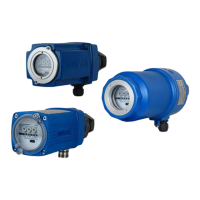3 | Explosion protection
22
D-LX 201/721
3.7 Explosion labelling
3.7.1 ATEX Markings
Explosion-protected devices in the European Union must be tested, approved and op-
erated in accordance with ATEX guidelines.
Housing ATEX labelling Ambient temperature Suitable for
II 2 G Ex d IIC T5 Gb -40 °C ≤ Ta ≤ +85 °C Zone 1 and
zone 2
II 2 G Ex d IIC T6 Gb -40 °C ≤ Ta ≤ +70 °C
II 2 D Ex tb IIIC T100 °C Db -40 °C ≤ Ta ≤ +85 °C Zone 21 and
zone 22
II 2 D Ex tb IIIC T85 °C Db -40 °C ≤ Ta ≤ +70 °C
II 3 G Ex nAnC IIC T4 Gc -40 °C ≤ Ta ≤ +65 °C Zone 2
II 3 G Ex nAnC IIC T6 Gc -40 °C ≤ Ta ≤ +40 °C
II 3 D Ex tc IIIC T135 °C Dc -40 °C ≤ Ta ≤ +65 °C Zone 22
II 3 D Ex tc IIIC T85 °C Dc -40 °C ≤ Ta ≤ +40 °C
EU type examination certificate number
IBExU11ATEX1050 X
3.7.2 Labelling as per NEC 500
The NEC 500 and NEC 505 Standards are decisive in the type approval for explosion-
protected devices in North America. Devices with the corresponding labellings are ap-
proved for use in so-called
hazardous (classified) locations
. The NEC 500 sets out the
following classifications and labellings:
Class
Distinctions are made between devices that can be used in areas with the following
different atmospheric properties:
● Class I: flammable gases, vapours or mist
● Class II: flammable dust
● Class III: flammable fibres and lint
Divisions
An additional criterion is the frequency or period of time that the substances are emit-
ted at a dangerous concentration.
●
Division 1
: constant or occasional presence (under normal operating conditions) of
the ambient conditions described in the
Classes
section.
●
Division 2
: rare presence, or presence that is unexpected in the particular environ-
ment (under normal operating conditions), of the ambient conditions described in
the
Classes
section.
Groups
Potentially explosive substances are further classified into Groups. For Class I, gases,
vapours and mist can be sub-divided into Groups A, B, C and D. Flammable dust is
sub-divided into Groups E, F and G.

